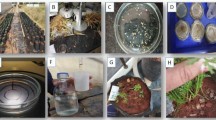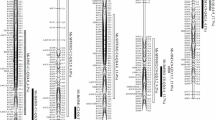Abstract
Carrots are highly susceptible to root-knot nematodes (RKN) which reduce their marketability due to deformation of roots. Hence, there is a need to identify resistant sources against RKN to accelerate resistance breeding programmes in carrot. In the current study, forty-eight carrot accessions were screened by artificial inoculation of nematodes to locate the lines resistant to Meloidogyne incognita. Among all, Acc- 88 was found to be immune to M. incognita followed by Acc-72, Acc-145 and KSP-123 which showed a moderately resistant reaction. Acc -113B was highly susceptible while the other 44 lines showed a susceptible reaction towards M. incognita. The accessions were validated for the Mj gene using linked molecular markers conferring resistance to RKN. The immune line, Acc-88 amplified at 266 bp proving the presence of resistance allele and Acc-113B generated the product size of the susceptible allele revealing a polymorphic difference with the ESSR0110 marker. The Mj resistance locus carrying Acc-88 has the potential to introgress RKN resistance in susceptible varieties of carrot. The validated ESSR0110 co-dominant molecular marker is promising because it could effectively distinguish resistant and susceptible individuals, thus helps the breeder to develop stable source resistance to root knot nematode. This finding is the first report on identification of immune linse and linked molecular marker in tropical carrot against M. incognita.




Similar content being viewed by others
Data Availability
All data supporting the findings of this study are available within the paper and its Supplementary Information.
References
Ali, A., Matthews, M. C., Cavagnaro, P. F., Iorizzo, M., Roberts, P. A., & Simon, P. W. (2014). Inheritance and map** of Mj-2, a new source of root-knot nematode (Meloidogyne javanica) Resistance in carrot. Journal of Heredity, 105, 288–291.
Anonymous. (2016). National Horticulture Board, Government of India, Gurugram 122015, India.
AOAC Assn. of official analytical chemists. (2000). Coffee and tea. In: Official methods of analysis. 17th ed. Gaithersburg, Md.: AOAC.
Boiteux, L. S., Hyman, J. R., Bach, I. C., Fonseca, M. E. N., Matthews, W. C., Roberts, P. A., & Simon, P. W. (2004). Employment of flanking co-dominant STS markers to estimate allelic substitution effects of a nematode resistance locus in carrot. Euphytica, 136, 37–44.
Byrd, D. W., Jr., Kirkpatrick, T., & Barker, K. R. (1983). An improved technique for clearing and staining tissues for detection of nematodes. Journal of Nematology, 15, 142–143.
Cavagnaro, P. F., Chung, S. M., Manin, S., Yildiz, M., Ali, A., Alessandro, M. S., & Iorizzo, M. (2011). Microsatellite isolation and marker development in carrot - genomic distribution, linkage map**, genetic diversity analysis and marker transferability across Apiaceae. BMC Genomics, 12, 386.
Cobb N. A. (1918). Estimating the nematode population of the soil Bureau of Plant Industry. United States Department of Agriculture, Agricultural Technology Circular 1:19–24.
Cousins, P. & Walker, M. A. (1998). Improved techniques for evaluating root-knot nematode resistance in Vitis rootstocks. In VII International Symposium on Grapevine Genetics and Breeding 528 pp. 575–577.
Doyle, J. J., & Doyle, J. L. (1990). Isolation of plant DNA from fresh tissue. Focus, 12, 13–15.
Dropkin, V. H., Helgeson, J. P., & Upper, C. D. (1969). The hypersensitivity reaction of tomatoes resistant to Meloidogyne incognita: Reversal by cytokinins. Journal of Nematology, 1(1), 55.
Eisenback, J. D. & Triantaphyllou, H. H. (2020). Root-knot nematodes: Meloidogyne species and races. In Manual of Agricultural Nematology (pp. 191–274). CRC Press
Gugino, B. K., Abawi, G. S., & Ludwig, J. W. (2006). Damage and management of Meloidognye hapla using oxamyl on carrot in New York. Journal of Nematology, 38, 483–490.
Kalia, P., Chug, C., Chinthagunti, H., Mangal, M., Mishra, S., & Singh, S. (2019). In Vitro screening technique and polymorphic DNA markers for introgression of root-knot nematode resistance in tropical carrot. Indian Journal of Horticulture, 76(3), 430–437.
Khan, F., Asif, M., Khan, A., Tariq, M., & Siddiqui, M. A. (2018). Screening of carrot cultivars against root-knot nematode Meloidogyne incognita. Indian Phytopathology, 71(3), 415–421.
Kumar, V., Khan, M. R., & Walia, R. K. (2020). Crop loss estimations due to plant-parasitic nematodes in major crops in India. National Academy Science Letters, 43(5), 409–412.
Nelson, S. C., Starr, J. L., & Simpson, C. E. (1990). Expression of resistance to Meloidogyne arenaria in Arachis batizocoi and Arachis cardenasii. Journal of Nematology, 22, 423–425.
Nisha, M. S., Narayana, R., & Sheela, M. S. (2012). Occurrence of root-knot nematode, Meloidogyne incognita on carrot in Kerala. Indian Journal of Nematology, 42, 196–197.
Panse, V. G., & Sukhatme, P. V. (1985). Statistical Methods for Agricultural Workers. Indian Council of Agricultural Research.
Parsons, J., Matthews, W., Iorizzo, M., Roberts, & Simon, P. W. (2015). Meloidogyne incognita nematode resistance QTL in carrot. Molecular Breeding, 35(5), 1–11.
Riaz, N., Zubaida Yousaf, Z. Y., Munawar, M., Younas, A., Rashid, M., Aftab, A., Shamsheer, B., Yasin, H., Najeebullah, M. and Simon, P. W. (2021). Development of carrot nutraceutical products as an alternative supplement for the prevention of nutritional diseases. Frontiers in Nutrition, 8, 1–19.
Sasser, J. N., Carter, C. C. (1982). Overview of the International Meloidogyne project rationale, goals, implementation and progress to date. Proceedings of Conference on Root-Knot nematodes Meloidogyne spp. (Region 111). Brasillia Brazil. pp. 3–13.
Seenivasan, N. (2017). Status of root-knot nematode, Meloidogyne hapla infection on carrot at Kodaikanal hills of Tamil Nadu, India and its yield loss estimation. International Journal of Current Microbiology and Applied Sciences, 6, 3629–3635.
Simon, P. W., Matthews, W. C., & Roberts, P. A. (2000). Evidence for simply inherited dominant resistance to Meloidogyne javanica in carrot. TAG. Theoretical and Applied Genetics., 100, 735–742.
Singleton, V. L., Orthofer, R., & Lamuela-Raventos, R. M. (1999). Analysis of total phenols and other oxidation substrates and antioxidants by means of folin-ciocalteu reagent. Methods in Enzymology, 299(14), 152–178.
Taylor, A. L., & Sasser, J. N. (1978). Biology, Identification and Control of Root-Knot Nematodes (Meloidogyne Species) (p 111). USA, Department of Plant Pathology, North Carolina State University & United States Agency for International Development.
Vovlas, N., Mifsud, D., Landa, B. B., & Castillo, P. (2005). Pathogenicity of the root-knot nematode Meloidogyne javanica on potato. Plant Pathology, 54, 657–664.
Williamson, V. M., & Kumar, A. (2006). Nematode resistance in plants: The battle underground. Trends in Genetics, 22, 396–403.
Acknowledgements
The study was made possible by funding from DST, Ministry of science, Government of India. We would like to express our heartfelt appreciation to the Director of the ICAR-Indian Institute of Horticultural Research, Bengaluru, for his active support and guidance throughout the course of this research.
Funding
The finding provided by Indian Agricultural Research Institute-Indian Institute of Horticultural research, Bengaluru, India.
Author information
Authors and Affiliations
Corresponding author
Ethics declarations
Ethical approval
This paper does not contain on human or animal participants.
Conflict of interest
Authors have no conflict of interest to express.
Supplementary Information
Below is the link to the electronic supplementary material.
Rights and permissions
Springer Nature or its licensor (e.g. a society or other partner) holds exclusive rights to this article under a publishing agreement with the author(s) or other rightsholder(s); author self-archiving of the accepted manuscript version of this article is solely governed by the terms of such publishing agreement and applicable law.
About this article
Cite this article
Manisha, Padmini, K., Umamaheswari, R. et al. Evaluation of a resistant line of tropical carrot to root-knot nematode Meloidogyne incognita using conventional method and molecular markers. Eur J Plant Pathol 168, 363–371 (2024). https://doi.org/10.1007/s10658-023-02758-0
Accepted:
Published:
Issue Date:
DOI: https://doi.org/10.1007/s10658-023-02758-0




